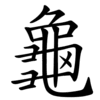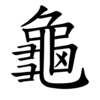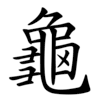龜
| ||||||||
| ||||||||
| ||||||||
| ||||||||
| ||||||||
 | ||||||||
| ||||||||
Translingual
| Stroke order | |||
|---|---|---|---|
 | |||
| Stroke order (Hong Kong) | |||
|---|---|---|---|
 | |||
| Stroke order (alternative) | |||
|---|---|---|---|
 | |||
| Traditional | 龜 |
|---|---|
| Shinjitai | 亀 |
| Simplified | 龟 |
Han character
龜 (Kangxi radical 213, 龜+0, 18 strokes in traditional Chinese, Japanese and Korean, 16 strokes in mainland China, cangjie input 竹月尸尸 (HBSS) or 弓X山 (NXU), four-corner 27117, composition ⿱⺈⿻⿺乚丨⿵冂⿰一一⿴⿻⿹𠃌一⿱⿱𠃍一⿱𠃍一㐅(H) or ⿹⿱丿⿱⿵冂⿰一一⿺⿺乚丨⿴⿱𠃍一㐅⿱⿻⿱𠃍一一⿻⿱𠃍一一(G) or ⿱丿⿻⿺乚丨⿵冂⿰一一⿴⿻⿹𠃌一⿱⿱𠃍一⿱𠃍一㐅)
- Kangxi radical #213, ⿔.
References
- KangXi: page 1537, character 23
- Dai Kanwa Jiten: character 48847
- Dae Jaweon: page 2078, character 18
- Hanyu Da Zidian (first edition): volume 7, page 4809, character 4
- Unihan data for U+9F9C
- Unihan data for U+F907
- Unihan data for U+F908
- Unihan data for U+FACE
Chinese
| trad. | 龜 | |
|---|---|---|
| simp. | 龟 | |
| alternative forms | ||
Glyph origin
| Historical forms of the character 龜 | |||
|---|---|---|---|
| Shang | Western Zhou | Shuowen Jiezi (compiled in Han) | Liushutong (compiled in Ming) |
| Oracle bone script | Bronze inscriptions | Small seal script | Transcribed ancient scripts |
 |
 |
 |
 |
Characters in the same phonetic series (龜) (Zhengzhang, 2003)
Pictogram (象形) : A drawing of a turtle seen from the side and from above (Bronze inscriptions).
Etymology 1
Austroasiatic. Compare Mon ဂွိ (gwi, “soft-shell turtle”), Nyah Kur ทะวี่ʔ (tha wìiʼ, “soft-shell turtle”) (Schuessler, 2007).
Pronunciation
Definitions
龜
- turtle; tortoise (Classifier: 隻/只 c)
- 何謂四靈?麟鳳龜龍,謂之四靈。 [Classical Chinese, trad.]
- From: The Book of Rites, c. 4th – 2nd century BCE
- Héwèi sìlíng? Lín fèng guī lóng, wèi zhī sìlíng. [Pinyin]
- What are the four numinous animals? The lin, the feng, the tortoise, and the dragon; those are called the four numinous animals.
何谓四灵?麟凤龟龙,谓之四灵。 [Classical Chinese, simp.]
- (figurative) cuckold
- (Cantonese, humorous) signature (Classifier: 隻/只 c)
- (Hong Kong Cantonese, slang) police
Synonyms
- (tortoise):
Dialectal synonyms of 烏龜 (“tortoise; turtle”) [map]
Compounds
Derived terms from 龜
|
|
Descendants
- → Zhuang: gvi
Pronunciation
Pronunciation
Definitions
龜
- (of skin) to crack; to become chapped
- 宋人有善為不龜手之藥者,世世以洴澼絖為事。 [Classical Chinese, trad.]
- From: Zhuangzi, circa 3rd – 2nd centuries BCE
- Sòng rén yǒu shàn wéi bù jūnshǒu zhī yào zhě, shìshì yǐ píngpìkuàng wéi shì. [Pinyin]
- There was a man of Song who was skilful at making a salve for chapped hands; and (his family) for generations had made the bleaching of cocoon-silk their business.
宋人有善为不龟手之药者,世世以洴澼𬘢为事。 [Classical Chinese, simp.]
Japanese
| 亀 | |
| 龜 |
Readings
- Go-on: き (ki)←き (ki, historical)
- Kan-on: き (ki)←き (ki, historical)
- Kun: かめ (kame, 龜)
From Middle Chinese 龜 (MC kɨu), as in 龜茲 (Kyūji)
Definitions
| Kanji in this term |
|---|
| 龜 |
| かめ Hyōgaiji |
| kun’yomi |
| Kanji in this term |
|---|
| 龜 |
| き Hyōgaiji |
| on’yomi |
| For pronunciation and definitions of 龜 – see the following entry. | ||||
| ||||
| (This term, 龜, is an alternative spelling of the above terms.) |
Korean
Etymology 1
From Middle Chinese 龜 (MC kˠiuɪ).
| Historical readings |
|---|
|
Pronunciation
- (SK Standard/Seoul) IPA(key): [kɥi] ~ [ky]
- Phonetic hangul: [귀]
Compounds
Compounds
- 귀갑 (龜甲, gwigap)
- 귀각 (龜殼, gwigak)
- 귀모 (龜毛, gwimo)
- 귀배 (龜背, gwibae)
- 귀별 (龜鼈, gwibyeol)
- 귀복 (龜卜, gwibok)
- 귀옥 (龜玉, gwiok)
- 귀점 (龜占, gwijeom)
- 귀패 (龜貝, gwipae)
- 귀판 (龜板, gwipan)
- 맹귀 (盲龜, maenggwi)
- 수귀 (水龜, sugwi)
- 신귀 (神龜, sin'gwi)
- 영귀 (靈龜, yeonggwi)
- 장귀 (長龜, janggwi)
- 진귀 (秦龜, jin'gwi)
- 해귀 (海龜, haegwi)
- 휴귀 (蠵龜, hyugwi)
- 귀두 (龜頭, gwidu)
- 귀감 (龜鑑, gwigam, “warning; self-criticism”)
- 귀선 (龜船, gwiseon, “Turtle ship”)
Etymology 2
From Middle Chinese 龜 (MC kɨu).
| Historical readings |
|---|
|
Pronunciation
- (SK Standard/Seoul) IPA(key): [ku]
- Phonetic hangul: [구]
Compounds
Etymology 3
From Middle Chinese 龜.
| Historical readings |
|---|
|
Pronunciation
- (SK Standard/Seoul) IPA(key): [kjun]
- Phonetic hangul: [균]
Compounds
Old Japanese
Etymology
From Proto-Japonic *kamaCi.[1]
Noun
龜 (kame2) (kana かめ)
- a tortoise, turtle
- 711–712, Kojiki (Second scroll, Yamasachihiko and Umisachihiko)
- ...乘二龜甲一爲レ釣乍打羽擧來人遇二于速吸門一...
- (please add an English translation of this usage example)
- 711–712, Kojiki (Second scroll, Yamasachihiko and Umisachihiko)
- a tortoise shell used in 亀卜 (kiboku, “tortoise-shell divination”)
Descendants
- Japanese: 亀 (kame)
References
- Martin, Samuel E. (1987) The Japanese Language Through Time, New Haven, London: Yale University Press, →ISBN
Vietnamese
This article is issued from Wiktionary. The text is licensed under Creative Commons - Attribution - Sharealike. Additional terms may apply for the media files.